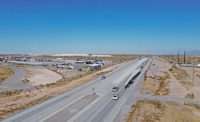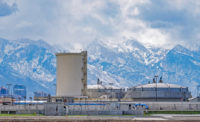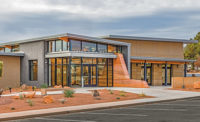Top Design Firms | Southwest Firm of the Year
EPS Group Builds on Its Pandemic Lessons

EPS Group provided civil engineering and landscape architecture for Marana Dove Mountain CSTEM, a combined elementary and middle school in Marana, Ariz.
Image courtesy of Corgan
Arizona design firm EPS Group has nearly doubled in size over the past four years, keeping its momentum on track throughout the pandemic, a feat its leaders attribute to lessons learned in diversification and its emphasis on company culture.
The firm’s offices in Mesa, Phoenix and Tucson specialize in land development, transportation and transit design, surveying, geospatial work, water resources and drainage, planning, landscape design, construction management and municipal engineering. EPS hired 84 new associates in the Southwest region in 2021, most of them in surveying and geospatial services, boosting its regional total to 285 employees.
EPS also recently opened a small satellite office in Northern Colorado and is scouting locations in Texas for a fifth office. The company posted $44.1 million in revenue for 2021, up from the $33.7 million it reported in 2020.
Diversity has been key to the firm’s growth—both geographically as well as in the services it offers.
The firm’s CEO Kathey Wagner says, “EPS Group was founded in 2003 by a small group of folks who had gone through a number of acquisitions and mergers and wanted to create a company that put its associates first. That secret sauce has worked, and our entrepreneurial spirit lives on today even as we are reaching 300 associates.”

The SR 347 Union Pacific Railroad Bridge Overpass project in Maricopa, Ariz., includes the design of a new bridge, traffic engineering and utility coordination for ADOT.
Image courtesy of EPS Group
People First
“We have spent a lot of time on our company culture over the past two years to make sure that as we continue to grow, the foundation of our success—[our people]—remains at the core of everything we do. It’s more important now than ever as our team is located in multiple locations and we continue to support hybrid work options for our team,” Wagner says. She was hired from outside the industry in 2018 to focus on strategic planning for EPS and was promoted to the role of CEO in 2019.
At EPS, a big piece of the culture is that when the firm wins, its associates win through a quarterly incentive program, Wagner explains. The company also introduced EPS University—an in-house program for associates to build technical and leadership skills through both classroom settings and cohort training. Other recent employee-focused initiatives include establishing a new hybrid work program (Work Your Way), formalizing the Path to Ownership initiative and “I Am EPS,” an associate engagement program.
“If you had told me two years ago that we would have success moving everyone remote, I would have doubted you.”
—Bryan Kitchen, Land Department Manager and Principal, EPS Group
“If you had told me two years ago that we would have success moving everyone remote, I would have doubted you,” says EPS land department manager and principal Bryan Kitchen. “While it was forced on us during the pandemic, we, by luck, had delved into Microsoft Teams about eight months prior [in order to] connect our various offices.”
While the pandemic pushed everyone into virtual interactions and collaboration, the new work arrangement worked so well for EPS that it instituted a new program called Work Your Way. Based on flexible scheduling and task-oriented accountability, the program also has helped to alleviate recruiting challenges and opened the national market to employees who want to live in and work from another state, Kitchen says. As a result, the majority of the firm’s new employees in the last three to four months have come from outside Arizona.
Intentional Growth
“While we have done a good job developing Arizona, now we are pushing to move forward geographically,” Kitchen says. “We weren’t as diversified during the Great Recession, and that was painful.”
EPS is working strategically with a client in Northern Colorado to solidify its market presence there. “This will be a growth market for some time to come,” Kitchen says.
In Southern California, just east of Irvine, EPS has two individuals working to bolster the market. “We’re looking at growing into Texas next. It’s a stable economy that will help us grow over time.”
“Our goal is to be a top five design firm by 2025 and a leader in the Southwest region,” Wagner says. “We’re looking at all our neighboring states to diversify geographically and our client base. We all know a market downturn will happen, and we need to be in a better position when it does.”
“The environmental and energy markets will be another good way for us to diversify—in addition to the geographical diversification—and we’re looking at moving into those markets as well,” Kitchen adds. “We’re trying to grasp the ability to work remotely and make that a permanent fixture of EPS Group, and we see that as a definite advantage [for expansion] moving forward.”

Phases 1 and 2 of Bella Vista Farms features 1,100 single-family lots, a community pool, playgrounds and walking paths in San Tan Valley, Ariz.
Image courtesy of EPS Group
Public Works
On the public works side, roadway design is the EPS Group’s bread and butter, says Greg Froehlich, EPS principal and public works department manager. The firm also performs water, sewer and gas line design and completed the sitework design during the pandemic for Phoenix Rising Stadium, a new 10,000-seat stadium at the Gila River Indian Community’s Wild Horse Pass in Chandler, Ariz. EPS Group provided land planning, civil engineering, surveying and landscape architecture services for the project.
In addition to expanding its reach geographically, EPS has continued to diversify its client base, which includes larger clients like the state of Arizona, along with smaller municipalities, developers and other public agency clients. “That diversification has brought a lot of work to EPS,” Froehlich says.
EPS is currently designing improvements to five miles of U.S.60X for the Arizona Dept. of Transportation (ADOT) and is working on a roadway project for the town of Gilbert. EPS recently designed an award-winning ADOT project, State Route 347 in Maricopa.
“We pride ourselves in being very available to our clients. We are trying to solve problems for them in the most efficient and effective way to save their budgets and schedule,” Froehlich adds.
Looking Ahead
Kitchen says that continued volatility—with the uptick in inflation, the constant increases in material costs and supply chain issues as well as the war in Ukraine—all have the potential to affect the firm’s growth. “We will continue to look at the build-to-rent housing sector and the industrial market to capture significant growth attributed to the current lack of affordability in housing and the almost nonexistent vacancy rates in the inland empire in California that is driving industrial development to the metro Phoenix market,” he says. “The federal dollars from the Build Back Better legislation that was passed late last year and that will be pushed into the market to combat our aging infrastructure is also our biggest opportunity as that money floods the market.”
In the build-to-rent sector, EPS recently provided land planning, civil engineering, surveying, landscape architecture and construction management services for BB Living on multiple projects within the Phoenix metro area. By providing a one-stop shop where EPS can carry the project from due diligence and entitlement to a finished horizontal product helps streamline development for BB Living.
EPS also is working with Willis Property on the planning and engineering of a 320-acre industrial site in Casa Grande to capitalize on the current industrial market, specifically within Casa Grande, a city in Pinal County that continues to see tremendous growth due to the influx of jobs with large employers like Lucid, Nikola and Kohler moving to the market. EPS also is assisting Willis Property on developing more than 4,000 single-family lots within the area to take advantage of the housing demand that will take place from this influx of industrial development and its associated employment needs.
“They are people people,” says Dale Willis, president, Willis Property, referring to EPS employees. “They handle the full gamut of planning, surveying, engineering and construction management, and they work great not only with us but also with city planning staff, community leaders [and others]. That’s what I’ve been impressed with, and they are just terrific to work alongside.”




